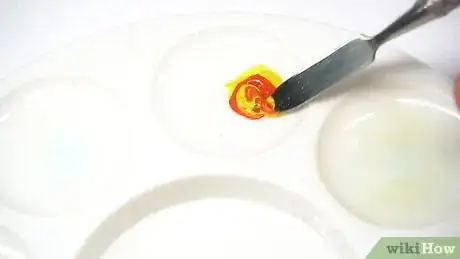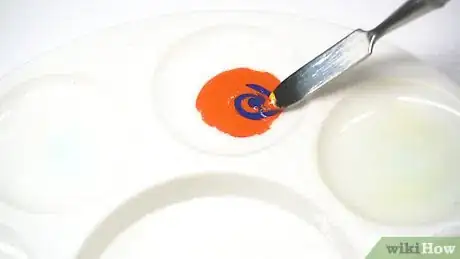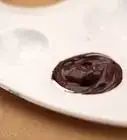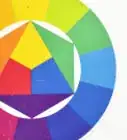This article was co-authored by Kelly Medford. Kelly Medford is an American painter based in Rome, Italy. She studied classical painting, drawing and printmaking both in the U.S. and in Italy. She works primarily en plein air on the streets of Rome, and also travels for private international collectors on commission. She founded Sketching Rome Tours in 2012 where she teaches sketchbook journaling to visitors of Rome. Kelly is a graduate of the Florence Academy of Art.
There are 9 references cited in this article, which can be found at the bottom of the page.
This article has been viewed 4,466,660 times.
Brown is a versatile color with many possible applications, but you may not always be able to find it in your art supplies. Fortunately, it’s possible to mix up a variety of earthy shades using only the primary colors: red, blue, and yellow. Just blend all three primary colors to produce a basic brown. You can also start with a secondary color like orange or green, then add its complementary primary color to get brown. Tweak the hue of your browns by using more of any one primary color, including a small amount of black, or combining two or more different shades.
Steps
Mixing the Primary Colors Equally
-
1Squeeze a small glob of each color onto your mixing surface. Add your red, blue, and yellow paints close together on your palette or paper. The exact amounts you use will differ depending on how much brown paint you need. The important thing is that you start with the same proportion of each.[1]
- Leave a little space between each color. This will create an open area in the middle where you can pull your paints together.
- Making brown from the primary colors is as simple as combining equal amounts of each.
Tip: Theoretically, these combinations could work for things like oil sticks, watercolors, and colored pencils, too. The end result may not be as uniform, though, since they'll be harder to blend.
-
2Blend the colors together thoroughly. Drag the tip of a palette knife through the inner edges of all three paints to pull them towards the center. Then, glide the flat bottom surface over the paints in a circular motion, gradually working your way outward to pick up more and more of each color. As you do, you’ll notice the mixture becoming a rich, creamy brown.[2]
- If you’re working with watercolors, oils sticks, or a similar medium, layer your primary colors directly on top of one another in light coats until you achieve the desired shade.
- A palette knife makes it possible to produce more uniform colors than you would get using a brush.[3]
Advertisement -
3Add a hint of white to give your brown more depth. Now that you’ve mixed up your base shade of brown, stir in a dab of white paint and continue blending until it disappears completely. Be careful not to use too much—in most cases, you’ll only need about ⅓ of your total amount of paint or less.[4]
- Introduce your white a little at a time. You can always add more if needed, but overdoing it may cause your brown to turn out dull and unsaturated.
- Incorporating some white into pencil, oil, and watercolor mixtures can help reduce the appearance of inconsistent blending.[5]
Creating Brown from Secondary Colors
-
1Mix together red and yellow to make orange. Start with a liberal amount of red. Then, add your yellow a little at a time—aim for a 1-1 ratio. Blend the two colors as you go until you end up with a deep orange.[6]
- In order for your brown to turn out sufficiently dark, you may need to use a hint more red than yellow.
-
2Blend blue with orange to get brown. Use just a little less blue than orange—it should make up no more than about 35-40% of the total color on the palette or paper. Spread the colors thoroughly until they form a chocolatey brown.[7]
- The more blue you put in, the more of a powdery, understated plum cast your brown will take on.
- Use ruddy browns to bring sun-drenched or rustic features to life.[8]
-
3Combine red and blue to create purple. Use equal parts of each color, or as close to it as you can get. The purple you’re after is a perfect amalgamation of red and blue, but it’s okay for it to lean towards magenta or a similar red-dominant shade if you’re having trouble with the proportions.[9]
- Purple can be a tricky color to get just right. If the finished product is a little too red or blue, just stir in a dab of the opposite color to balance it out.
- If your purple is too heavy on the blue, it may not look right when it comes time to add the complementary primary color. Red tends to be more forgiving.
-
4Stir yellow into purple gradually until you end up with brown. As you blend the paints, you’ll notice a tinge of dirty brown beginning to show through. Keep adding traces of yellow until you get the particular shade you’re going for.[10]
- Up the intensity of the yellow to correct an overly cool brown.
- You can produce a variety of brown hues ranging from a rose-tinted stoney color to a sandy desert tone, depending on how prominent the yellow is.[11]
-
5Mingle blue and yellow to produce green. Squeeze out a large glob of blue and add your yellow a little at a time. As with orange, you want to start with as bold a green as possible and work your way towards the middle of the spectrum.[12]
- For best results, you green should be closer to a deep cyan than a light aquamarine.
-
6Mix the desired amount of red with green to get brown. Layer on a smidge of red at first and continue adding and mixing as needed to darken the color. Infusing green with red tends to result in an earthy olive-brown at one extreme and a warm burnt-orange at the other.[13]
- To get as close to a “true” brown as possible, your mixture needs to be roughly 33-40% red. Even in virtually equal proportions, the red still may appear slightly more pronounced.
Tip: Browns made from red and green work especially well for landscapes and other sorts of natural scenes.
Tweaking the Shades You Produce
-
1Add a little extra red or yellow to give your brown a warmer tone. If you want to lighten or amplify a basic brown, simply mix in a bit more of one of the warm primary colors. Remember to portion and blend your paints gradually until you arrive at the particular shade you’re after.[14]
- If your brown accidentally ends up being too red or yellow, just stir in some blue to bring it back into balance.
- Warm browns are useful for painting details like wood surfaces, brick, soil, and the reflection of natural light sources.[15]
-
2Increase the amount of blue you use to create a cooler finish. Just as you can use red and yellow to make your browns bolder for colorful and well-lit outdoor scenes, adding blue will darken them and make them more subtle. Blue-deepened browns lend a realistic shadowy quality to forestscapes, buildings, hair, and the folds and wrinkles in clothing.[16]
- Adjust overly-cool browns with traces of red or yellow, keeping in mind how each color interacts with blue to create secondary shades.
-
3Use black to darken the various browns you come up with. Technically, black isn’t a primary color. However, it can be found in just about every set of art supplies, and is incredibly useful for evening out browns that are too vibrant for their intended purpose.
- A little black goes a long way. In most cases, you’ll only need a tiny bit to bring down the brightness of your brown considerably.[17]
Warning: Be careful not to get too heavy handed when mixing black with your existing colors. Remember, once you put it in, you can’t take it out.
-
4Mix multiple shades of brown together. Stirring one shade into another can be a fun and simple way to discover unexpected new shades. Try whipping up an assortment of browns using different pairings of primary colors (orange and blue or green and red, for instance). Then, blend one or more of them together and see what comes out![18]
- By combining several browns, you can make subtle changes to a shade rather than transforming it altogether and fine-tune your palette in the process.
Expert Q&A
Did you know you can get expert answers for this article?
Unlock expert answers by supporting wikiHow
-
QuestionWhat colors make light or dark brown?
 Kelly MedfordKelly Medford is an American painter based in Rome, Italy. She studied classical painting, drawing and printmaking both in the U.S. and in Italy. She works primarily en plein air on the streets of Rome, and also travels for private international collectors on commission. She founded Sketching Rome Tours in 2012 where she teaches sketchbook journaling to visitors of Rome. Kelly is a graduate of the Florence Academy of Art.
Kelly MedfordKelly Medford is an American painter based in Rome, Italy. She studied classical painting, drawing and printmaking both in the U.S. and in Italy. She works primarily en plein air on the streets of Rome, and also travels for private international collectors on commission. She founded Sketching Rome Tours in 2012 where she teaches sketchbook journaling to visitors of Rome. Kelly is a graduate of the Florence Academy of Art.
Professional Painter
-
QuestionCan I make hazel without using brown?
 Community Answer"Hazel" is a fairly ambiguous colour. But if you're looking to make a sort of brownish, goldish green like hazel eyes, you can make it with mostly yellow, a bit of green, and something to darken it slightly like black (only a little bit!) or dark grey.
Community Answer"Hazel" is a fairly ambiguous colour. But if you're looking to make a sort of brownish, goldish green like hazel eyes, you can make it with mostly yellow, a bit of green, and something to darken it slightly like black (only a little bit!) or dark grey. -
QuestionHow can I make purple?
 Community AnswerWhile mixing red and blue colors is traditional, it's useful to know how to make more nuanced purple colors. This article will help you: How to Make Purple Paint.
Community AnswerWhile mixing red and blue colors is traditional, it's useful to know how to make more nuanced purple colors. This article will help you: How to Make Purple Paint.
wikiHow Video: How to Make Brown from Primary Colors
Things You’ll Need
- Paints in primary colors
- Palette, mixing board, or sturdy paper
- Palette knife
- Oil sticks, watercolors, colored pencils, or crayons (optional)
References
- ↑ https://www.mybluprint.com/article/for-the-richest-brown-hues-you-wanna-mix-your-own-acrylic-paints
- ↑ http://helloartsy.com/palette-knife/
- ↑ http://helloartsy.com/palette-knife/
- ↑ https://marketingaccesspass.com/what-colors-make-brown-what-two-colors-make-brown/
- ↑ https://www.craftsy.com/art/article/brown-watercolor/
- ↑ https://www.infoplease.com/arts-entertainment/colors
- ↑ http://helloartsy.com/how-to-make-brown/
- ↑ https://marketingaccesspass.com/what-colors-make-brown-what-two-colors-make-brown/
- ↑ http://www.sensationalcolor.com/understanding-color/theory/color-relationships-primary-secondary-tertiary-hues-1842#.XB1leVxKjIU
- ↑ https://www.mybluprint.com/article/for-the-richest-brown-hues-you-wanna-mix-your-own-acrylic-paints
- ↑ http://helloartsy.com/how-to-make-brown/
- ↑ http://www.sensationalcolor.com/understanding-color/theory/color-relationships-primary-secondary-tertiary-hues-1842#.XB1leVxKjIU
- ↑ https://www.mybluprint.com/article/11-hacks-for-mixing-acrylic-paint-perfectly
- ↑ https://marketingaccesspass.com/what-colors-make-brown-what-two-colors-make-brown/
- ↑ https://www.mybluprint.com/article/for-the-richest-brown-hues-you-wanna-mix-your-own-acrylic-paints
- ↑ https://www.mybluprint.com/article/for-the-richest-brown-hues-you-wanna-mix-your-own-acrylic-paints
- ↑ http://www.visual-arts-cork.com/artist-paints/colour-mixing-tips.htm#colours
- ↑ http://www.visual-arts-cork.com/artist-paints/colour-mixing-tips.htm#colours
About This Article
To make brown paint using primary colors, mix together equal parts yellow, red, and blue paint. For a deeper, purplish-brown, add a little more blue. If you want a lighter, earthier brown, add a little more yellow. Adding more red will create a deep gray-brown with a hint of orange in it. To make your brown paint lighter, just mix in a little bit of white paint. To darken it, add a small amount of black. Continue adding primary colors, black, or white until you achieve your desired shade of brown. To learn how to adjust the shade of brown you create and make it darker or lighter, scroll down!




















































